Strategic Management and Leadership Report: Analysis and Review
VerifiedAdded on 2020/01/15
|10
|2811
|63
Report
AI Summary
This report provides a comprehensive analysis of strategic management and leadership skills, focusing on the impact of different leadership styles on organizational decision-making processes. It examines various management and leadership theories, including contingency management, Theory X and Theory Y, and transformational leadership, as applied in two established organizations, Nexus Ltd and Clover management consultancy. The report explores how these theories influence organizational strategies and operational practices, assessing their strengths and weaknesses. Furthermore, it delves into the application of leadership strategies, using Tesco as a case study to illustrate how a combination of leadership theories can be employed to achieve optimal results in a dynamic market environment. The analysis covers topics such as autocratic, participative, charismatic, and laissez-faire leadership styles, alongside transactional and democratic approaches, highlighting their respective impacts on employee morale, decision-making, and overall organizational performance.
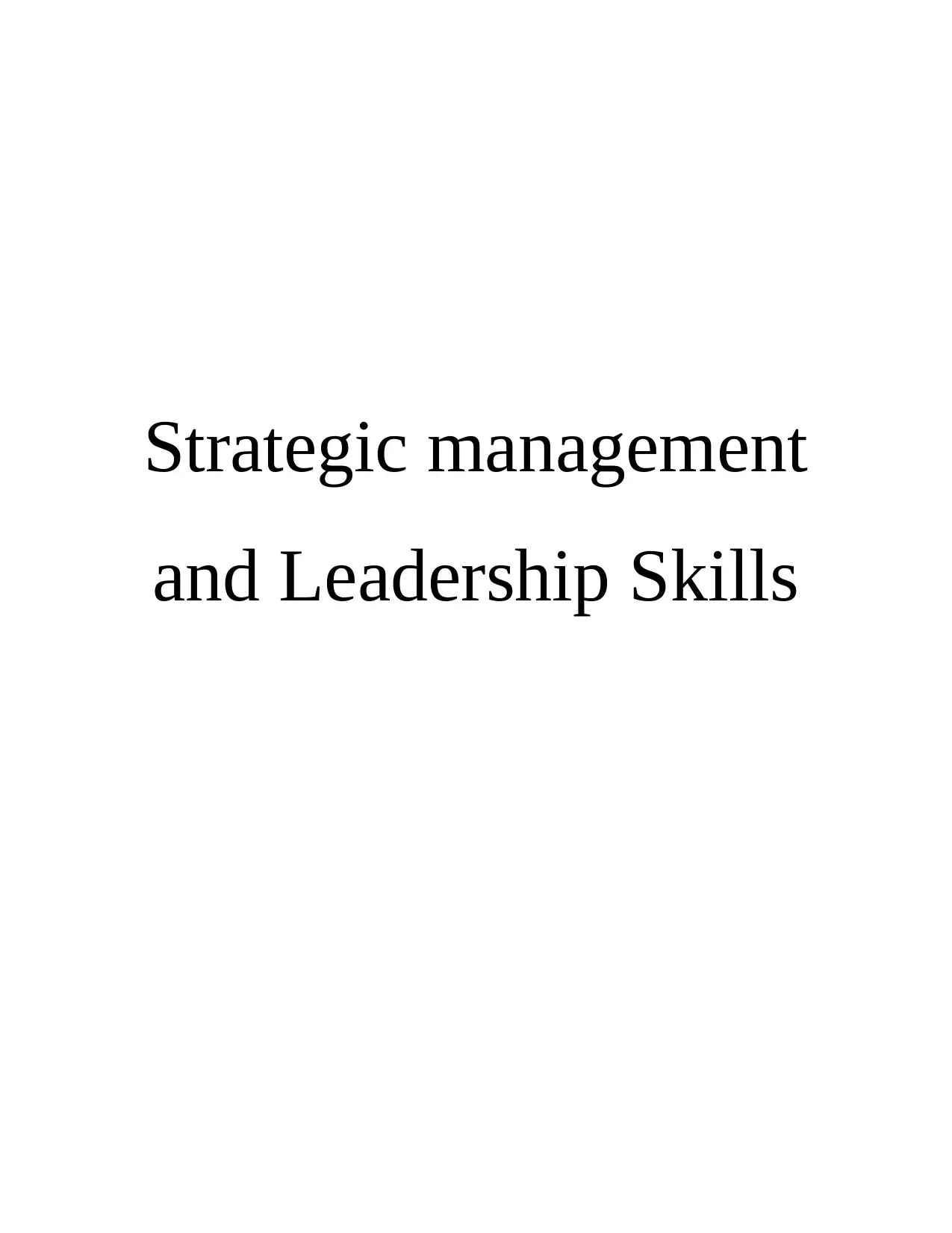
Strategic management
and Leadership Skills
and Leadership Skills
Paraphrase This Document
Need a fresh take? Get an instant paraphrase of this document with our AI Paraphraser
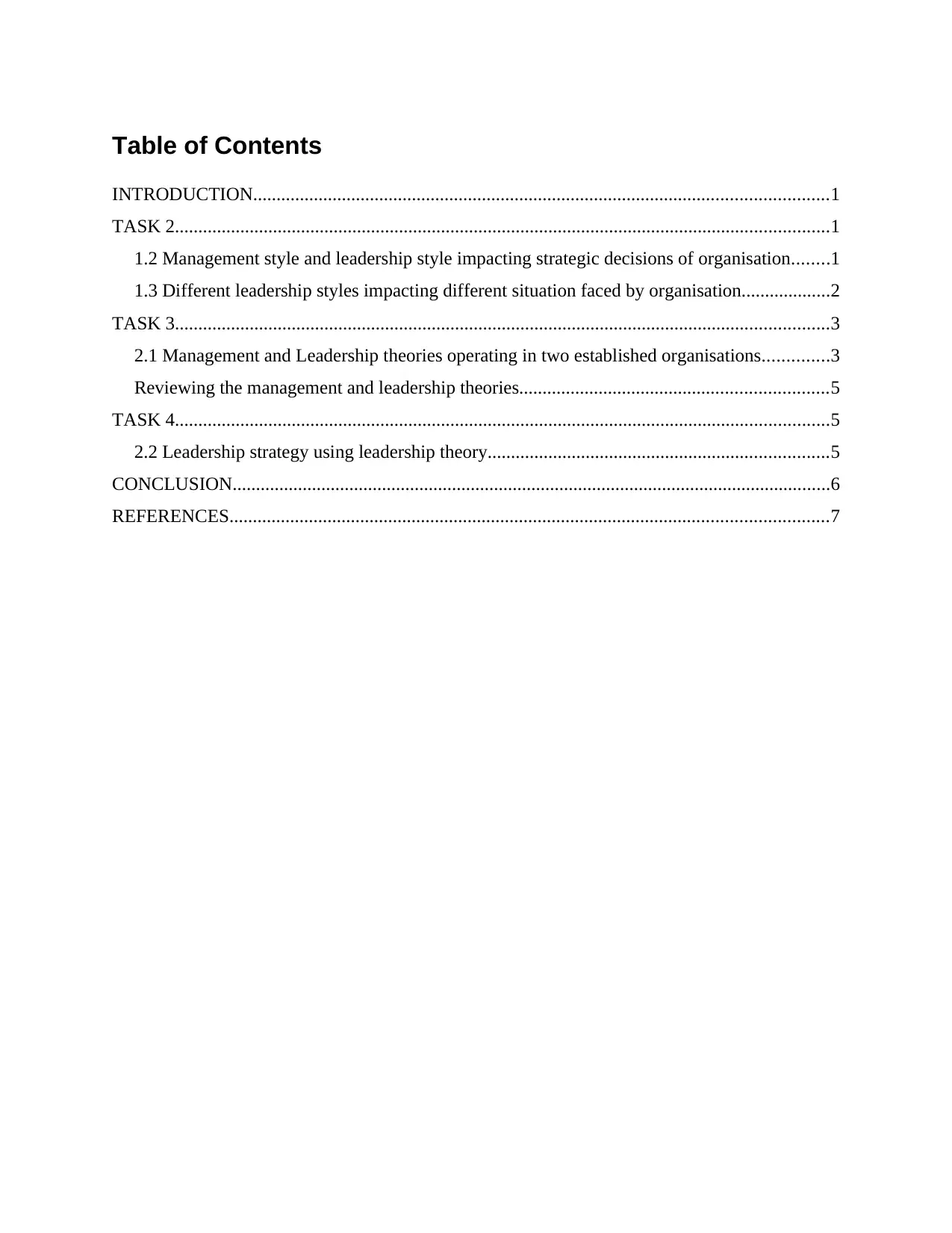
Table of Contents
INTRODUCTION...........................................................................................................................1
TASK 2............................................................................................................................................1
1.2 Management style and leadership style impacting strategic decisions of organisation........1
1.3 Different leadership styles impacting different situation faced by organisation...................2
TASK 3............................................................................................................................................3
2.1 Management and Leadership theories operating in two established organisations..............3
Reviewing the management and leadership theories..................................................................5
TASK 4............................................................................................................................................5
2.2 Leadership strategy using leadership theory.........................................................................5
CONCLUSION................................................................................................................................6
REFERENCES................................................................................................................................7
INTRODUCTION...........................................................................................................................1
TASK 2............................................................................................................................................1
1.2 Management style and leadership style impacting strategic decisions of organisation........1
1.3 Different leadership styles impacting different situation faced by organisation...................2
TASK 3............................................................................................................................................3
2.1 Management and Leadership theories operating in two established organisations..............3
Reviewing the management and leadership theories..................................................................5
TASK 4............................................................................................................................................5
2.2 Leadership strategy using leadership theory.........................................................................5
CONCLUSION................................................................................................................................6
REFERENCES................................................................................................................................7
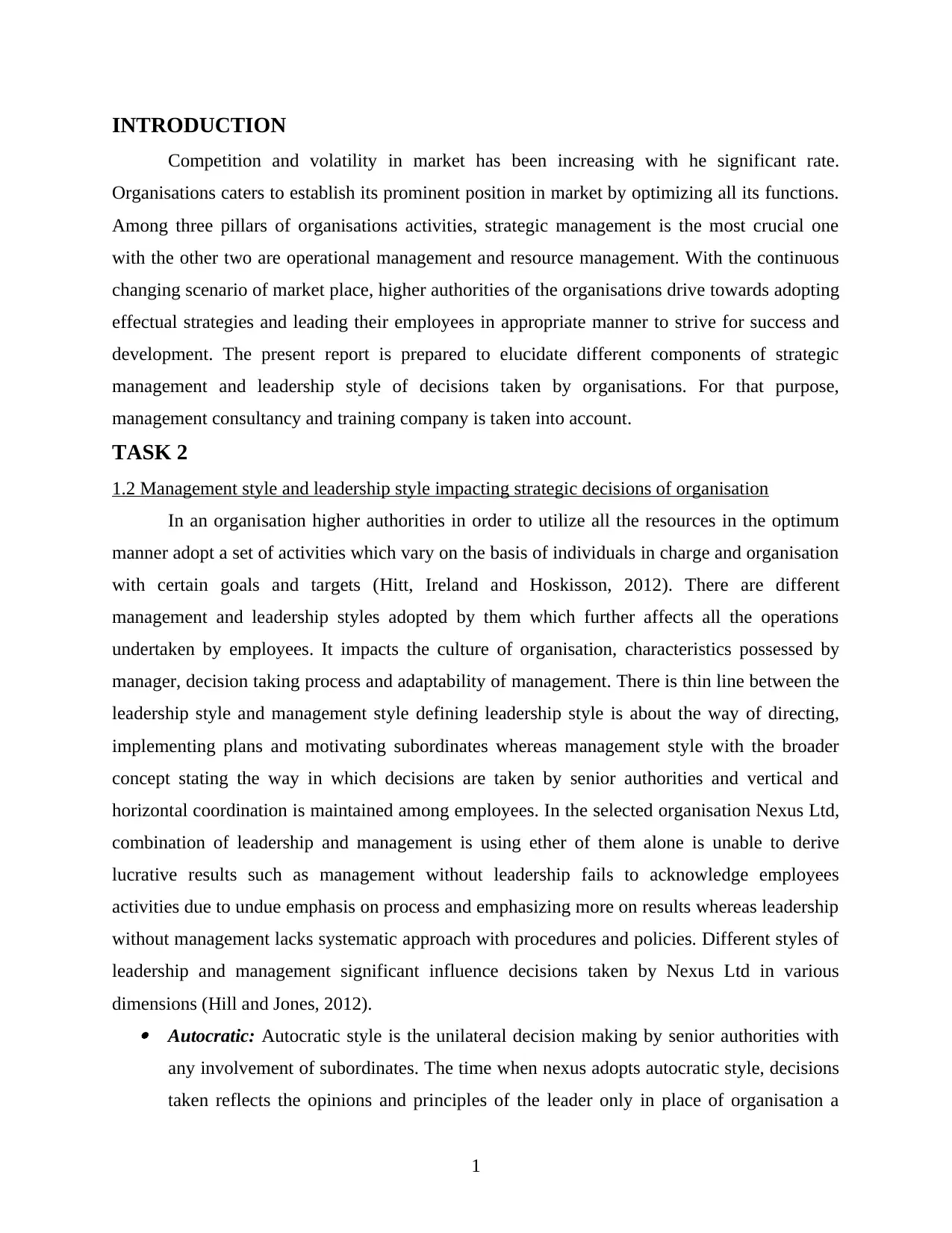
INTRODUCTION
Competition and volatility in market has been increasing with he significant rate.
Organisations caters to establish its prominent position in market by optimizing all its functions.
Among three pillars of organisations activities, strategic management is the most crucial one
with the other two are operational management and resource management. With the continuous
changing scenario of market place, higher authorities of the organisations drive towards adopting
effectual strategies and leading their employees in appropriate manner to strive for success and
development. The present report is prepared to elucidate different components of strategic
management and leadership style of decisions taken by organisations. For that purpose,
management consultancy and training company is taken into account.
TASK 2
1.2 Management style and leadership style impacting strategic decisions of organisation
In an organisation higher authorities in order to utilize all the resources in the optimum
manner adopt a set of activities which vary on the basis of individuals in charge and organisation
with certain goals and targets (Hitt, Ireland and Hoskisson, 2012). There are different
management and leadership styles adopted by them which further affects all the operations
undertaken by employees. It impacts the culture of organisation, characteristics possessed by
manager, decision taking process and adaptability of management. There is thin line between the
leadership style and management style defining leadership style is about the way of directing,
implementing plans and motivating subordinates whereas management style with the broader
concept stating the way in which decisions are taken by senior authorities and vertical and
horizontal coordination is maintained among employees. In the selected organisation Nexus Ltd,
combination of leadership and management is using ether of them alone is unable to derive
lucrative results such as management without leadership fails to acknowledge employees
activities due to undue emphasis on process and emphasizing more on results whereas leadership
without management lacks systematic approach with procedures and policies. Different styles of
leadership and management significant influence decisions taken by Nexus Ltd in various
dimensions (Hill and Jones, 2012). Autocratic: Autocratic style is the unilateral decision making by senior authorities with
any involvement of subordinates. The time when nexus adopts autocratic style, decisions
taken reflects the opinions and principles of the leader only in place of organisation a
1
Competition and volatility in market has been increasing with he significant rate.
Organisations caters to establish its prominent position in market by optimizing all its functions.
Among three pillars of organisations activities, strategic management is the most crucial one
with the other two are operational management and resource management. With the continuous
changing scenario of market place, higher authorities of the organisations drive towards adopting
effectual strategies and leading their employees in appropriate manner to strive for success and
development. The present report is prepared to elucidate different components of strategic
management and leadership style of decisions taken by organisations. For that purpose,
management consultancy and training company is taken into account.
TASK 2
1.2 Management style and leadership style impacting strategic decisions of organisation
In an organisation higher authorities in order to utilize all the resources in the optimum
manner adopt a set of activities which vary on the basis of individuals in charge and organisation
with certain goals and targets (Hitt, Ireland and Hoskisson, 2012). There are different
management and leadership styles adopted by them which further affects all the operations
undertaken by employees. It impacts the culture of organisation, characteristics possessed by
manager, decision taking process and adaptability of management. There is thin line between the
leadership style and management style defining leadership style is about the way of directing,
implementing plans and motivating subordinates whereas management style with the broader
concept stating the way in which decisions are taken by senior authorities and vertical and
horizontal coordination is maintained among employees. In the selected organisation Nexus Ltd,
combination of leadership and management is using ether of them alone is unable to derive
lucrative results such as management without leadership fails to acknowledge employees
activities due to undue emphasis on process and emphasizing more on results whereas leadership
without management lacks systematic approach with procedures and policies. Different styles of
leadership and management significant influence decisions taken by Nexus Ltd in various
dimensions (Hill and Jones, 2012). Autocratic: Autocratic style is the unilateral decision making by senior authorities with
any involvement of subordinates. The time when nexus adopts autocratic style, decisions
taken reflects the opinions and principles of the leader only in place of organisation a
1
⊘ This is a preview!⊘
Do you want full access?
Subscribe today to unlock all pages.

Trusted by 1+ million students worldwide
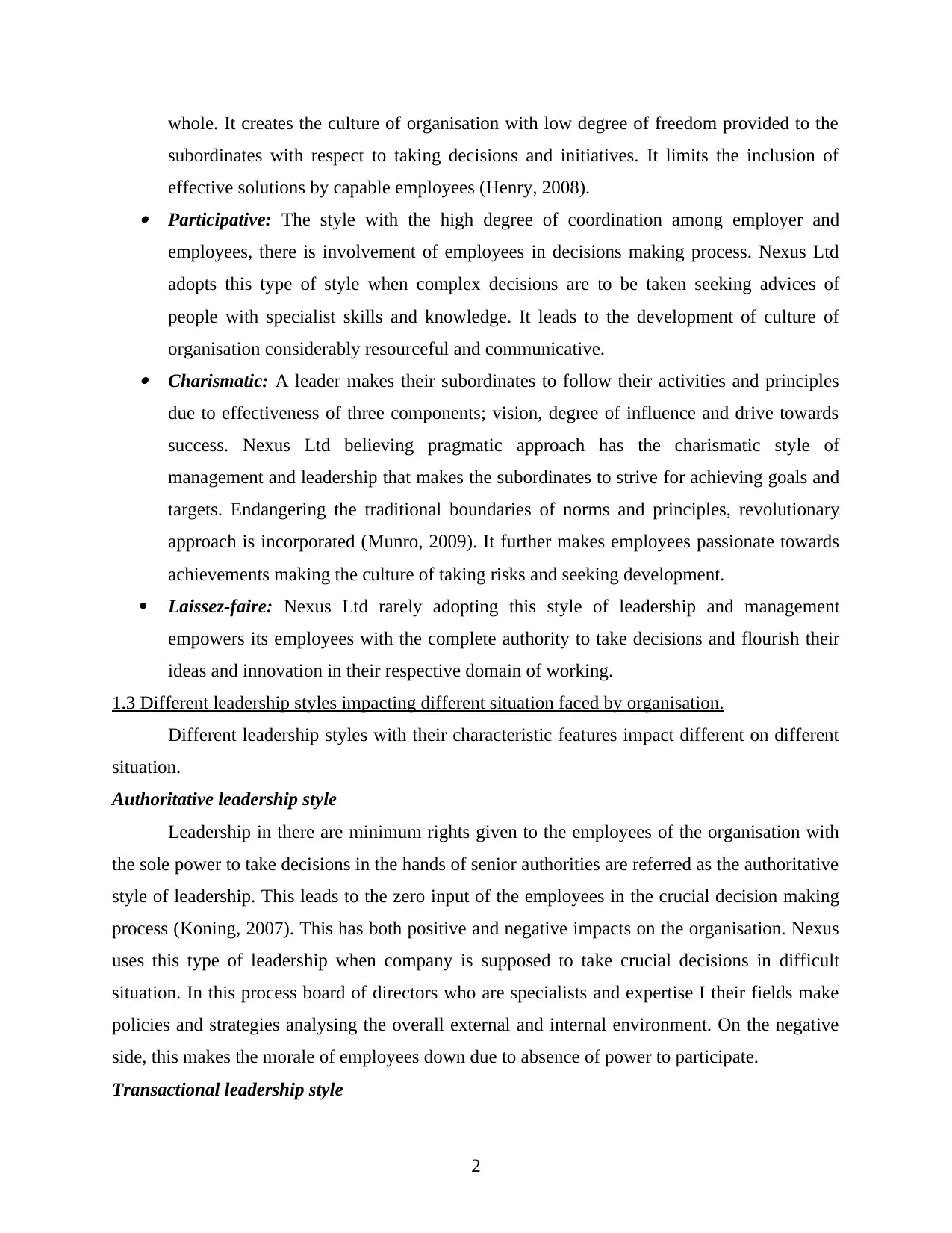
whole. It creates the culture of organisation with low degree of freedom provided to the
subordinates with respect to taking decisions and initiatives. It limits the inclusion of
effective solutions by capable employees (Henry, 2008). Participative: The style with the high degree of coordination among employer and
employees, there is involvement of employees in decisions making process. Nexus Ltd
adopts this type of style when complex decisions are to be taken seeking advices of
people with specialist skills and knowledge. It leads to the development of culture of
organisation considerably resourceful and communicative. Charismatic: A leader makes their subordinates to follow their activities and principles
due to effectiveness of three components; vision, degree of influence and drive towards
success. Nexus Ltd believing pragmatic approach has the charismatic style of
management and leadership that makes the subordinates to strive for achieving goals and
targets. Endangering the traditional boundaries of norms and principles, revolutionary
approach is incorporated (Munro, 2009). It further makes employees passionate towards
achievements making the culture of taking risks and seeking development.
Laissez-faire: Nexus Ltd rarely adopting this style of leadership and management
empowers its employees with the complete authority to take decisions and flourish their
ideas and innovation in their respective domain of working.
1.3 Different leadership styles impacting different situation faced by organisation.
Different leadership styles with their characteristic features impact different on different
situation.
Authoritative leadership style
Leadership in there are minimum rights given to the employees of the organisation with
the sole power to take decisions in the hands of senior authorities are referred as the authoritative
style of leadership. This leads to the zero input of the employees in the crucial decision making
process (Koning, 2007). This has both positive and negative impacts on the organisation. Nexus
uses this type of leadership when company is supposed to take crucial decisions in difficult
situation. In this process board of directors who are specialists and expertise I their fields make
policies and strategies analysing the overall external and internal environment. On the negative
side, this makes the morale of employees down due to absence of power to participate.
Transactional leadership style
2
subordinates with respect to taking decisions and initiatives. It limits the inclusion of
effective solutions by capable employees (Henry, 2008). Participative: The style with the high degree of coordination among employer and
employees, there is involvement of employees in decisions making process. Nexus Ltd
adopts this type of style when complex decisions are to be taken seeking advices of
people with specialist skills and knowledge. It leads to the development of culture of
organisation considerably resourceful and communicative. Charismatic: A leader makes their subordinates to follow their activities and principles
due to effectiveness of three components; vision, degree of influence and drive towards
success. Nexus Ltd believing pragmatic approach has the charismatic style of
management and leadership that makes the subordinates to strive for achieving goals and
targets. Endangering the traditional boundaries of norms and principles, revolutionary
approach is incorporated (Munro, 2009). It further makes employees passionate towards
achievements making the culture of taking risks and seeking development.
Laissez-faire: Nexus Ltd rarely adopting this style of leadership and management
empowers its employees with the complete authority to take decisions and flourish their
ideas and innovation in their respective domain of working.
1.3 Different leadership styles impacting different situation faced by organisation.
Different leadership styles with their characteristic features impact different on different
situation.
Authoritative leadership style
Leadership in there are minimum rights given to the employees of the organisation with
the sole power to take decisions in the hands of senior authorities are referred as the authoritative
style of leadership. This leads to the zero input of the employees in the crucial decision making
process (Koning, 2007). This has both positive and negative impacts on the organisation. Nexus
uses this type of leadership when company is supposed to take crucial decisions in difficult
situation. In this process board of directors who are specialists and expertise I their fields make
policies and strategies analysing the overall external and internal environment. On the negative
side, this makes the morale of employees down due to absence of power to participate.
Transactional leadership style
2
Paraphrase This Document
Need a fresh take? Get an instant paraphrase of this document with our AI Paraphraser
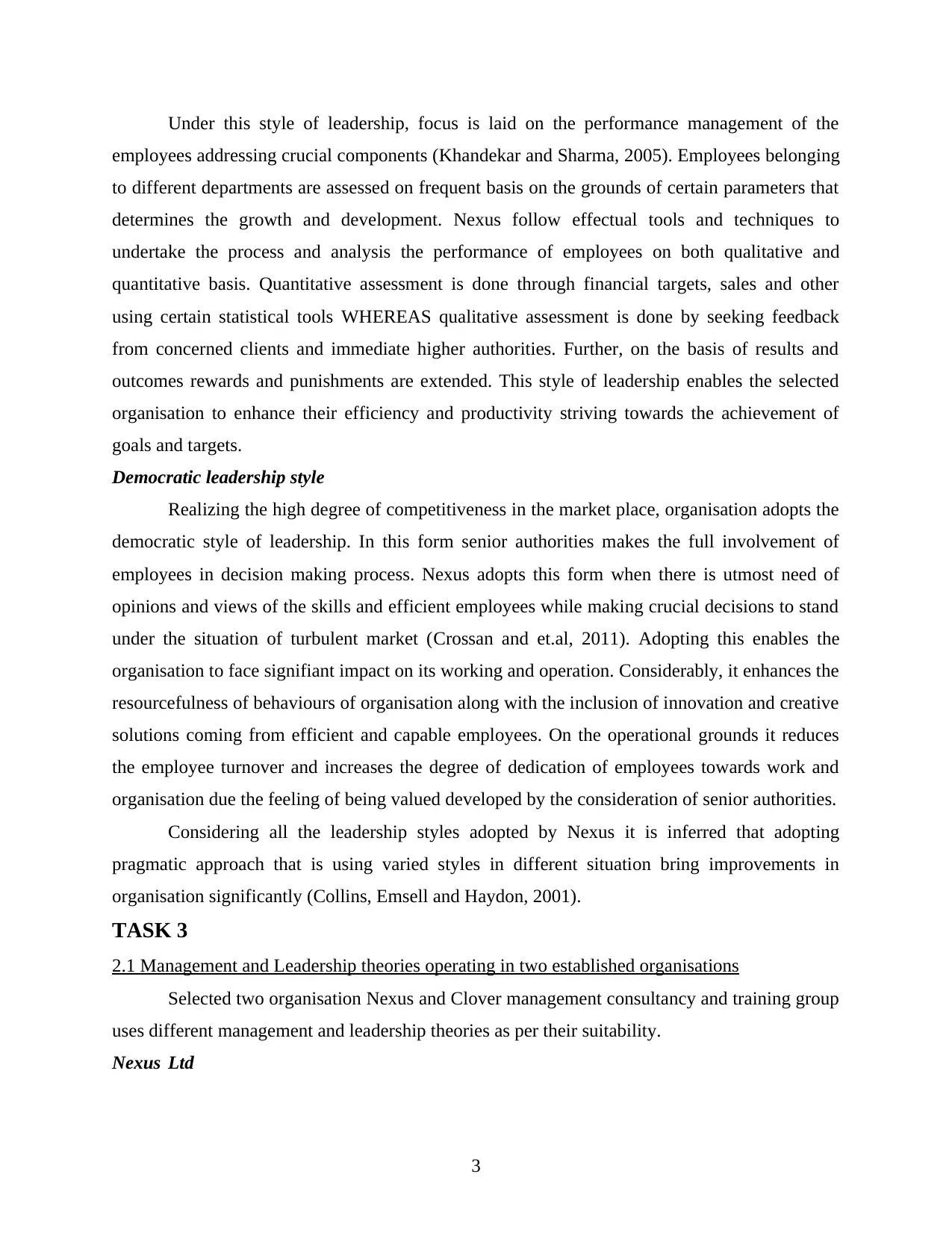
Under this style of leadership, focus is laid on the performance management of the
employees addressing crucial components (Khandekar and Sharma, 2005). Employees belonging
to different departments are assessed on frequent basis on the grounds of certain parameters that
determines the growth and development. Nexus follow effectual tools and techniques to
undertake the process and analysis the performance of employees on both qualitative and
quantitative basis. Quantitative assessment is done through financial targets, sales and other
using certain statistical tools WHEREAS qualitative assessment is done by seeking feedback
from concerned clients and immediate higher authorities. Further, on the basis of results and
outcomes rewards and punishments are extended. This style of leadership enables the selected
organisation to enhance their efficiency and productivity striving towards the achievement of
goals and targets.
Democratic leadership style
Realizing the high degree of competitiveness in the market place, organisation adopts the
democratic style of leadership. In this form senior authorities makes the full involvement of
employees in decision making process. Nexus adopts this form when there is utmost need of
opinions and views of the skills and efficient employees while making crucial decisions to stand
under the situation of turbulent market (Crossan and et.al, 2011). Adopting this enables the
organisation to face signifiant impact on its working and operation. Considerably, it enhances the
resourcefulness of behaviours of organisation along with the inclusion of innovation and creative
solutions coming from efficient and capable employees. On the operational grounds it reduces
the employee turnover and increases the degree of dedication of employees towards work and
organisation due the feeling of being valued developed by the consideration of senior authorities.
Considering all the leadership styles adopted by Nexus it is inferred that adopting
pragmatic approach that is using varied styles in different situation bring improvements in
organisation significantly (Collins, Emsell and Haydon, 2001).
TASK 3
2.1 Management and Leadership theories operating in two established organisations
Selected two organisation Nexus and Clover management consultancy and training group
uses different management and leadership theories as per their suitability.
Nexus Ltd
3
employees addressing crucial components (Khandekar and Sharma, 2005). Employees belonging
to different departments are assessed on frequent basis on the grounds of certain parameters that
determines the growth and development. Nexus follow effectual tools and techniques to
undertake the process and analysis the performance of employees on both qualitative and
quantitative basis. Quantitative assessment is done through financial targets, sales and other
using certain statistical tools WHEREAS qualitative assessment is done by seeking feedback
from concerned clients and immediate higher authorities. Further, on the basis of results and
outcomes rewards and punishments are extended. This style of leadership enables the selected
organisation to enhance their efficiency and productivity striving towards the achievement of
goals and targets.
Democratic leadership style
Realizing the high degree of competitiveness in the market place, organisation adopts the
democratic style of leadership. In this form senior authorities makes the full involvement of
employees in decision making process. Nexus adopts this form when there is utmost need of
opinions and views of the skills and efficient employees while making crucial decisions to stand
under the situation of turbulent market (Crossan and et.al, 2011). Adopting this enables the
organisation to face signifiant impact on its working and operation. Considerably, it enhances the
resourcefulness of behaviours of organisation along with the inclusion of innovation and creative
solutions coming from efficient and capable employees. On the operational grounds it reduces
the employee turnover and increases the degree of dedication of employees towards work and
organisation due the feeling of being valued developed by the consideration of senior authorities.
Considering all the leadership styles adopted by Nexus it is inferred that adopting
pragmatic approach that is using varied styles in different situation bring improvements in
organisation significantly (Collins, Emsell and Haydon, 2001).
TASK 3
2.1 Management and Leadership theories operating in two established organisations
Selected two organisation Nexus and Clover management consultancy and training group
uses different management and leadership theories as per their suitability.
Nexus Ltd
3
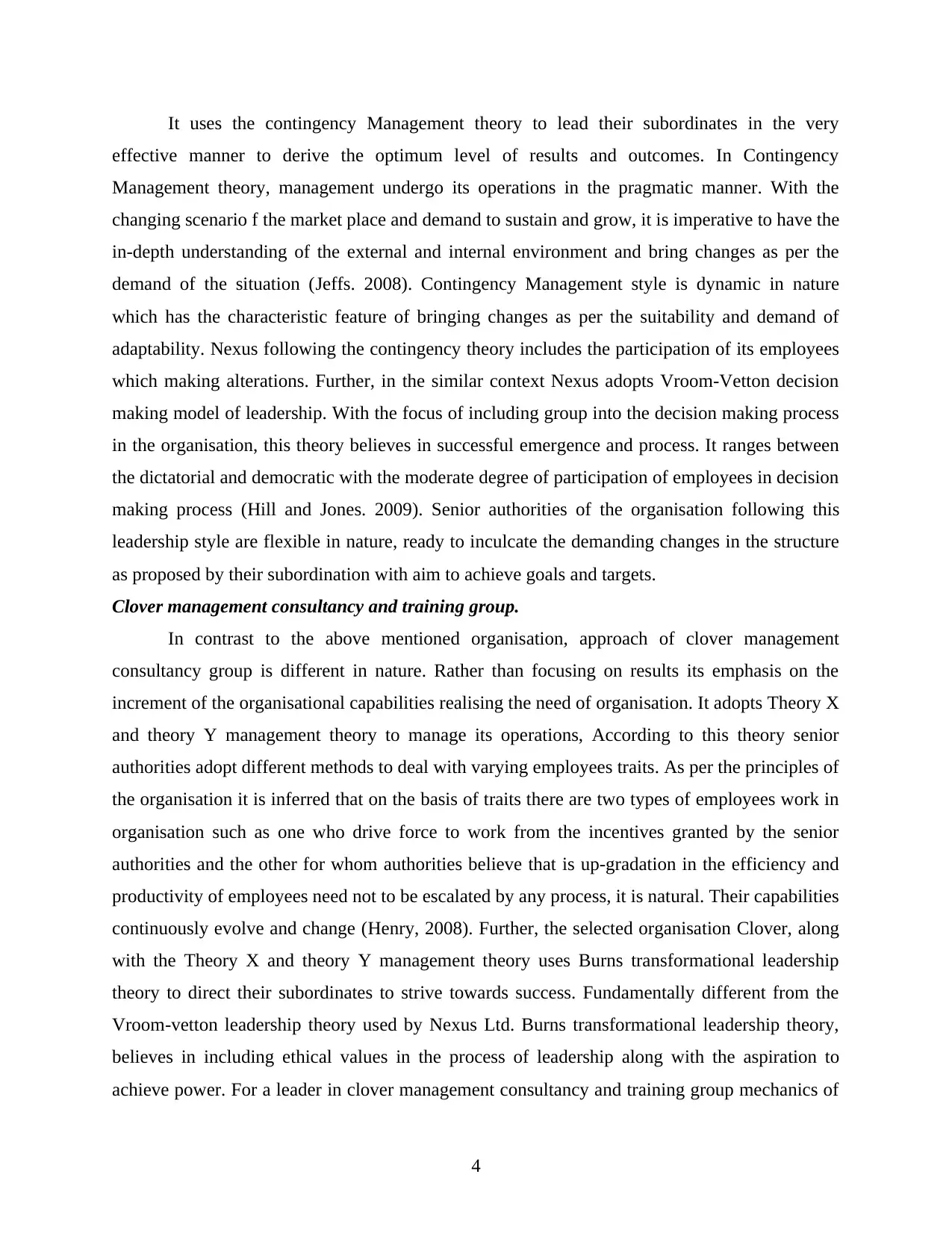
It uses the contingency Management theory to lead their subordinates in the very
effective manner to derive the optimum level of results and outcomes. In Contingency
Management theory, management undergo its operations in the pragmatic manner. With the
changing scenario f the market place and demand to sustain and grow, it is imperative to have the
in-depth understanding of the external and internal environment and bring changes as per the
demand of the situation (Jeffs. 2008). Contingency Management style is dynamic in nature
which has the characteristic feature of bringing changes as per the suitability and demand of
adaptability. Nexus following the contingency theory includes the participation of its employees
which making alterations. Further, in the similar context Nexus adopts Vroom-Vetton decision
making model of leadership. With the focus of including group into the decision making process
in the organisation, this theory believes in successful emergence and process. It ranges between
the dictatorial and democratic with the moderate degree of participation of employees in decision
making process (Hill and Jones. 2009). Senior authorities of the organisation following this
leadership style are flexible in nature, ready to inculcate the demanding changes in the structure
as proposed by their subordination with aim to achieve goals and targets.
Clover management consultancy and training group.
In contrast to the above mentioned organisation, approach of clover management
consultancy group is different in nature. Rather than focusing on results its emphasis on the
increment of the organisational capabilities realising the need of organisation. It adopts Theory X
and theory Y management theory to manage its operations, According to this theory senior
authorities adopt different methods to deal with varying employees traits. As per the principles of
the organisation it is inferred that on the basis of traits there are two types of employees work in
organisation such as one who drive force to work from the incentives granted by the senior
authorities and the other for whom authorities believe that is up-gradation in the efficiency and
productivity of employees need not to be escalated by any process, it is natural. Their capabilities
continuously evolve and change (Henry, 2008). Further, the selected organisation Clover, along
with the Theory X and theory Y management theory uses Burns transformational leadership
theory to direct their subordinates to strive towards success. Fundamentally different from the
Vroom-vetton leadership theory used by Nexus Ltd. Burns transformational leadership theory,
believes in including ethical values in the process of leadership along with the aspiration to
achieve power. For a leader in clover management consultancy and training group mechanics of
4
effective manner to derive the optimum level of results and outcomes. In Contingency
Management theory, management undergo its operations in the pragmatic manner. With the
changing scenario f the market place and demand to sustain and grow, it is imperative to have the
in-depth understanding of the external and internal environment and bring changes as per the
demand of the situation (Jeffs. 2008). Contingency Management style is dynamic in nature
which has the characteristic feature of bringing changes as per the suitability and demand of
adaptability. Nexus following the contingency theory includes the participation of its employees
which making alterations. Further, in the similar context Nexus adopts Vroom-Vetton decision
making model of leadership. With the focus of including group into the decision making process
in the organisation, this theory believes in successful emergence and process. It ranges between
the dictatorial and democratic with the moderate degree of participation of employees in decision
making process (Hill and Jones. 2009). Senior authorities of the organisation following this
leadership style are flexible in nature, ready to inculcate the demanding changes in the structure
as proposed by their subordination with aim to achieve goals and targets.
Clover management consultancy and training group.
In contrast to the above mentioned organisation, approach of clover management
consultancy group is different in nature. Rather than focusing on results its emphasis on the
increment of the organisational capabilities realising the need of organisation. It adopts Theory X
and theory Y management theory to manage its operations, According to this theory senior
authorities adopt different methods to deal with varying employees traits. As per the principles of
the organisation it is inferred that on the basis of traits there are two types of employees work in
organisation such as one who drive force to work from the incentives granted by the senior
authorities and the other for whom authorities believe that is up-gradation in the efficiency and
productivity of employees need not to be escalated by any process, it is natural. Their capabilities
continuously evolve and change (Henry, 2008). Further, the selected organisation Clover, along
with the Theory X and theory Y management theory uses Burns transformational leadership
theory to direct their subordinates to strive towards success. Fundamentally different from the
Vroom-vetton leadership theory used by Nexus Ltd. Burns transformational leadership theory,
believes in including ethical values in the process of leadership along with the aspiration to
achieve power. For a leader in clover management consultancy and training group mechanics of
4
⊘ This is a preview!⊘
Do you want full access?
Subscribe today to unlock all pages.

Trusted by 1+ million students worldwide
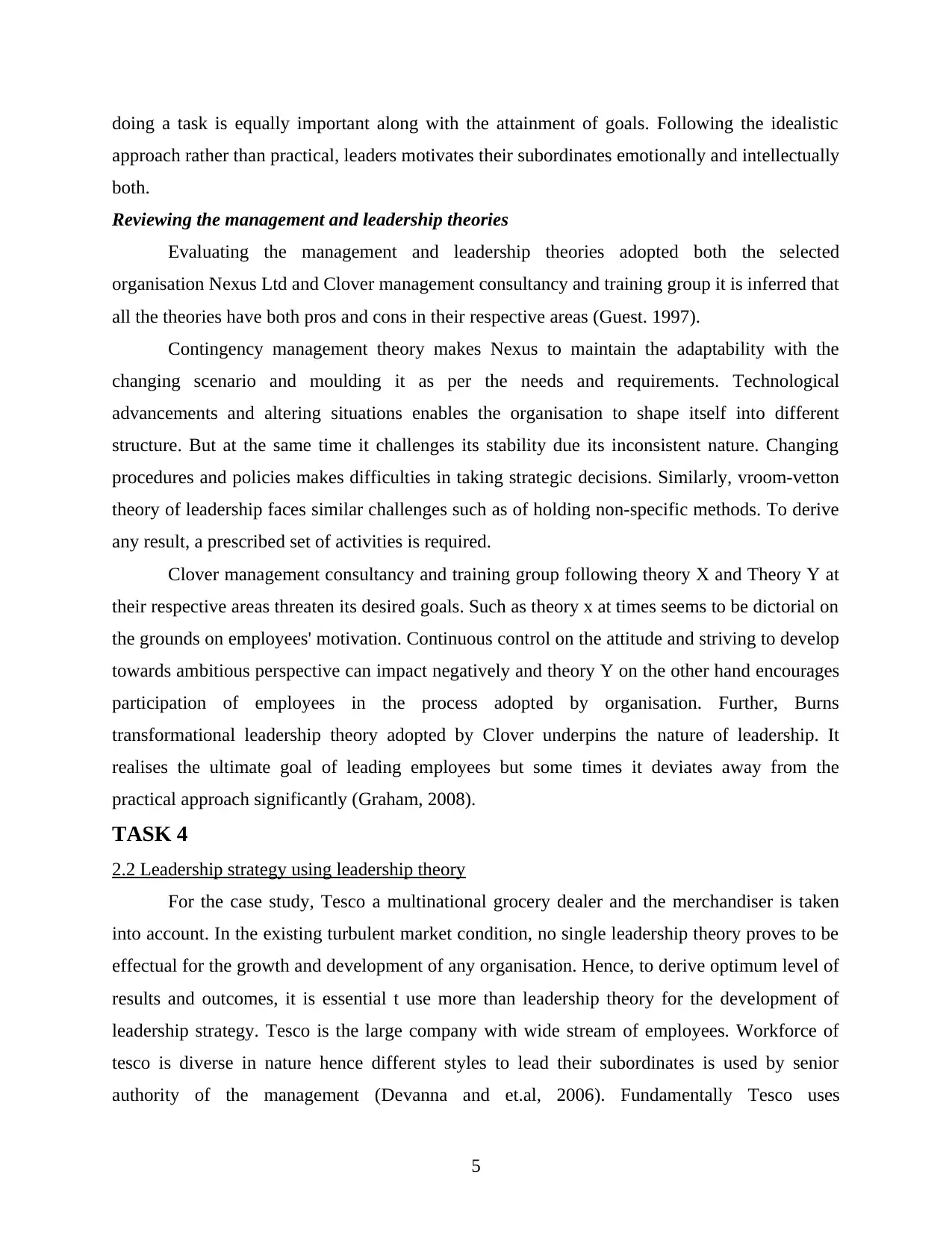
doing a task is equally important along with the attainment of goals. Following the idealistic
approach rather than practical, leaders motivates their subordinates emotionally and intellectually
both.
Reviewing the management and leadership theories
Evaluating the management and leadership theories adopted both the selected
organisation Nexus Ltd and Clover management consultancy and training group it is inferred that
all the theories have both pros and cons in their respective areas (Guest. 1997).
Contingency management theory makes Nexus to maintain the adaptability with the
changing scenario and moulding it as per the needs and requirements. Technological
advancements and altering situations enables the organisation to shape itself into different
structure. But at the same time it challenges its stability due its inconsistent nature. Changing
procedures and policies makes difficulties in taking strategic decisions. Similarly, vroom-vetton
theory of leadership faces similar challenges such as of holding non-specific methods. To derive
any result, a prescribed set of activities is required.
Clover management consultancy and training group following theory X and Theory Y at
their respective areas threaten its desired goals. Such as theory x at times seems to be dictorial on
the grounds on employees' motivation. Continuous control on the attitude and striving to develop
towards ambitious perspective can impact negatively and theory Y on the other hand encourages
participation of employees in the process adopted by organisation. Further, Burns
transformational leadership theory adopted by Clover underpins the nature of leadership. It
realises the ultimate goal of leading employees but some times it deviates away from the
practical approach significantly (Graham, 2008).
TASK 4
2.2 Leadership strategy using leadership theory
For the case study, Tesco a multinational grocery dealer and the merchandiser is taken
into account. In the existing turbulent market condition, no single leadership theory proves to be
effectual for the growth and development of any organisation. Hence, to derive optimum level of
results and outcomes, it is essential t use more than leadership theory for the development of
leadership strategy. Tesco is the large company with wide stream of employees. Workforce of
tesco is diverse in nature hence different styles to lead their subordinates is used by senior
authority of the management (Devanna and et.al, 2006). Fundamentally Tesco uses
5
approach rather than practical, leaders motivates their subordinates emotionally and intellectually
both.
Reviewing the management and leadership theories
Evaluating the management and leadership theories adopted both the selected
organisation Nexus Ltd and Clover management consultancy and training group it is inferred that
all the theories have both pros and cons in their respective areas (Guest. 1997).
Contingency management theory makes Nexus to maintain the adaptability with the
changing scenario and moulding it as per the needs and requirements. Technological
advancements and altering situations enables the organisation to shape itself into different
structure. But at the same time it challenges its stability due its inconsistent nature. Changing
procedures and policies makes difficulties in taking strategic decisions. Similarly, vroom-vetton
theory of leadership faces similar challenges such as of holding non-specific methods. To derive
any result, a prescribed set of activities is required.
Clover management consultancy and training group following theory X and Theory Y at
their respective areas threaten its desired goals. Such as theory x at times seems to be dictorial on
the grounds on employees' motivation. Continuous control on the attitude and striving to develop
towards ambitious perspective can impact negatively and theory Y on the other hand encourages
participation of employees in the process adopted by organisation. Further, Burns
transformational leadership theory adopted by Clover underpins the nature of leadership. It
realises the ultimate goal of leading employees but some times it deviates away from the
practical approach significantly (Graham, 2008).
TASK 4
2.2 Leadership strategy using leadership theory
For the case study, Tesco a multinational grocery dealer and the merchandiser is taken
into account. In the existing turbulent market condition, no single leadership theory proves to be
effectual for the growth and development of any organisation. Hence, to derive optimum level of
results and outcomes, it is essential t use more than leadership theory for the development of
leadership strategy. Tesco is the large company with wide stream of employees. Workforce of
tesco is diverse in nature hence different styles to lead their subordinates is used by senior
authority of the management (Devanna and et.al, 2006). Fundamentally Tesco uses
5
Paraphrase This Document
Need a fresh take? Get an instant paraphrase of this document with our AI Paraphraser
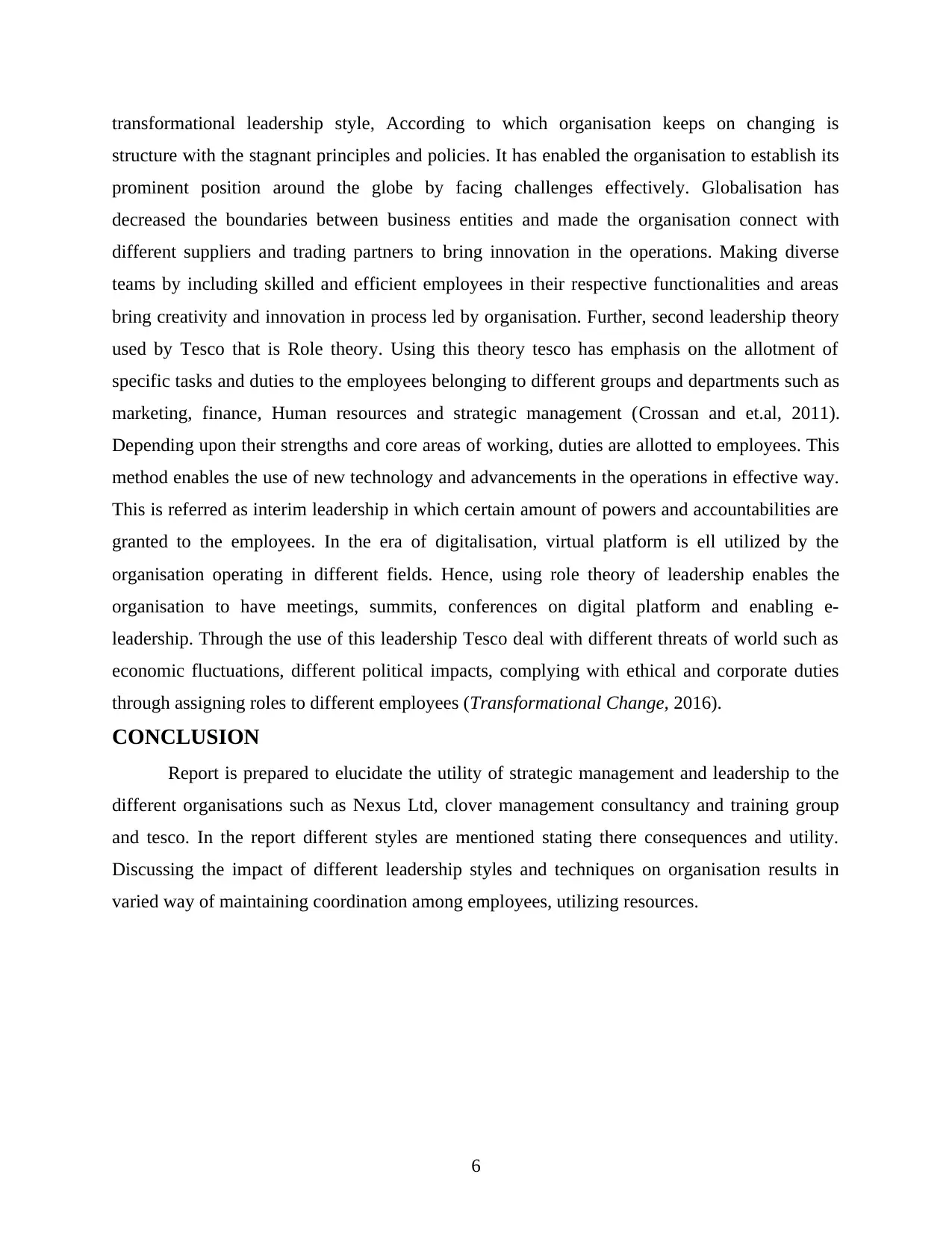
transformational leadership style, According to which organisation keeps on changing is
structure with the stagnant principles and policies. It has enabled the organisation to establish its
prominent position around the globe by facing challenges effectively. Globalisation has
decreased the boundaries between business entities and made the organisation connect with
different suppliers and trading partners to bring innovation in the operations. Making diverse
teams by including skilled and efficient employees in their respective functionalities and areas
bring creativity and innovation in process led by organisation. Further, second leadership theory
used by Tesco that is Role theory. Using this theory tesco has emphasis on the allotment of
specific tasks and duties to the employees belonging to different groups and departments such as
marketing, finance, Human resources and strategic management (Crossan and et.al, 2011).
Depending upon their strengths and core areas of working, duties are allotted to employees. This
method enables the use of new technology and advancements in the operations in effective way.
This is referred as interim leadership in which certain amount of powers and accountabilities are
granted to the employees. In the era of digitalisation, virtual platform is ell utilized by the
organisation operating in different fields. Hence, using role theory of leadership enables the
organisation to have meetings, summits, conferences on digital platform and enabling e-
leadership. Through the use of this leadership Tesco deal with different threats of world such as
economic fluctuations, different political impacts, complying with ethical and corporate duties
through assigning roles to different employees (Transformational Change, 2016).
CONCLUSION
Report is prepared to elucidate the utility of strategic management and leadership to the
different organisations such as Nexus Ltd, clover management consultancy and training group
and tesco. In the report different styles are mentioned stating there consequences and utility.
Discussing the impact of different leadership styles and techniques on organisation results in
varied way of maintaining coordination among employees, utilizing resources.
6
structure with the stagnant principles and policies. It has enabled the organisation to establish its
prominent position around the globe by facing challenges effectively. Globalisation has
decreased the boundaries between business entities and made the organisation connect with
different suppliers and trading partners to bring innovation in the operations. Making diverse
teams by including skilled and efficient employees in their respective functionalities and areas
bring creativity and innovation in process led by organisation. Further, second leadership theory
used by Tesco that is Role theory. Using this theory tesco has emphasis on the allotment of
specific tasks and duties to the employees belonging to different groups and departments such as
marketing, finance, Human resources and strategic management (Crossan and et.al, 2011).
Depending upon their strengths and core areas of working, duties are allotted to employees. This
method enables the use of new technology and advancements in the operations in effective way.
This is referred as interim leadership in which certain amount of powers and accountabilities are
granted to the employees. In the era of digitalisation, virtual platform is ell utilized by the
organisation operating in different fields. Hence, using role theory of leadership enables the
organisation to have meetings, summits, conferences on digital platform and enabling e-
leadership. Through the use of this leadership Tesco deal with different threats of world such as
economic fluctuations, different political impacts, complying with ethical and corporate duties
through assigning roles to different employees (Transformational Change, 2016).
CONCLUSION
Report is prepared to elucidate the utility of strategic management and leadership to the
different organisations such as Nexus Ltd, clover management consultancy and training group
and tesco. In the report different styles are mentioned stating there consequences and utility.
Discussing the impact of different leadership styles and techniques on organisation results in
varied way of maintaining coordination among employees, utilizing resources.
6
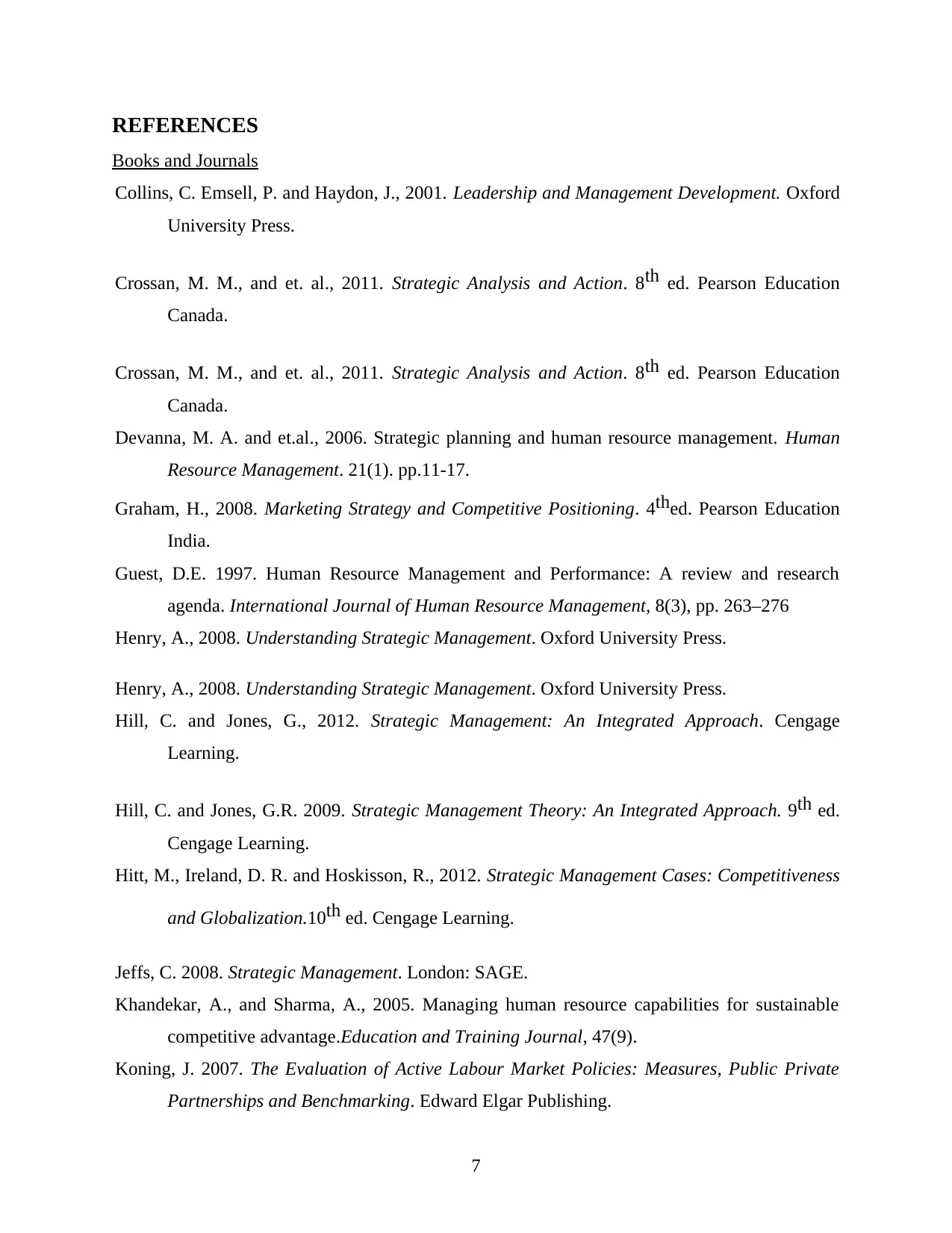
REFERENCES
Books and Journals
Collins, C. Emsell, P. and Haydon, J., 2001. Leadership and Management Development. Oxford
University Press.
Crossan, M. M., and et. al., 2011. Strategic Analysis and Action. 8th ed. Pearson Education
Canada.
Crossan, M. M., and et. al., 2011. Strategic Analysis and Action. 8th ed. Pearson Education
Canada.
Devanna, M. A. and et.al., 2006. Strategic planning and human resource management. Human
Resource Management. 21(1). pp.11-17.
Graham, H., 2008. Marketing Strategy and Competitive Positioning. 4thed. Pearson Education
India.
Guest, D.E. 1997. Human Resource Management and Performance: A review and research
agenda. International Journal of Human Resource Management, 8(3), pp. 263–276
Henry, A., 2008. Understanding Strategic Management. Oxford University Press.
Henry, A., 2008. Understanding Strategic Management. Oxford University Press.
Hill, C. and Jones, G., 2012. Strategic Management: An Integrated Approach. Cengage
Learning.
Hill, C. and Jones, G.R. 2009. Strategic Management Theory: An Integrated Approach. 9th ed.
Cengage Learning.
Hitt, M., Ireland, D. R. and Hoskisson, R., 2012. Strategic Management Cases: Competitiveness
and Globalization.10th ed. Cengage Learning.
Jeffs, C. 2008. Strategic Management. London: SAGE.
Khandekar, A., and Sharma, A., 2005. Managing human resource capabilities for sustainable
competitive advantage.Education and Training Journal, 47(9).
Koning, J. 2007. The Evaluation of Active Labour Market Policies: Measures, Public Private
Partnerships and Benchmarking. Edward Elgar Publishing.
7
Books and Journals
Collins, C. Emsell, P. and Haydon, J., 2001. Leadership and Management Development. Oxford
University Press.
Crossan, M. M., and et. al., 2011. Strategic Analysis and Action. 8th ed. Pearson Education
Canada.
Crossan, M. M., and et. al., 2011. Strategic Analysis and Action. 8th ed. Pearson Education
Canada.
Devanna, M. A. and et.al., 2006. Strategic planning and human resource management. Human
Resource Management. 21(1). pp.11-17.
Graham, H., 2008. Marketing Strategy and Competitive Positioning. 4thed. Pearson Education
India.
Guest, D.E. 1997. Human Resource Management and Performance: A review and research
agenda. International Journal of Human Resource Management, 8(3), pp. 263–276
Henry, A., 2008. Understanding Strategic Management. Oxford University Press.
Henry, A., 2008. Understanding Strategic Management. Oxford University Press.
Hill, C. and Jones, G., 2012. Strategic Management: An Integrated Approach. Cengage
Learning.
Hill, C. and Jones, G.R. 2009. Strategic Management Theory: An Integrated Approach. 9th ed.
Cengage Learning.
Hitt, M., Ireland, D. R. and Hoskisson, R., 2012. Strategic Management Cases: Competitiveness
and Globalization.10th ed. Cengage Learning.
Jeffs, C. 2008. Strategic Management. London: SAGE.
Khandekar, A., and Sharma, A., 2005. Managing human resource capabilities for sustainable
competitive advantage.Education and Training Journal, 47(9).
Koning, J. 2007. The Evaluation of Active Labour Market Policies: Measures, Public Private
Partnerships and Benchmarking. Edward Elgar Publishing.
7
⊘ This is a preview!⊘
Do you want full access?
Subscribe today to unlock all pages.

Trusted by 1+ million students worldwide
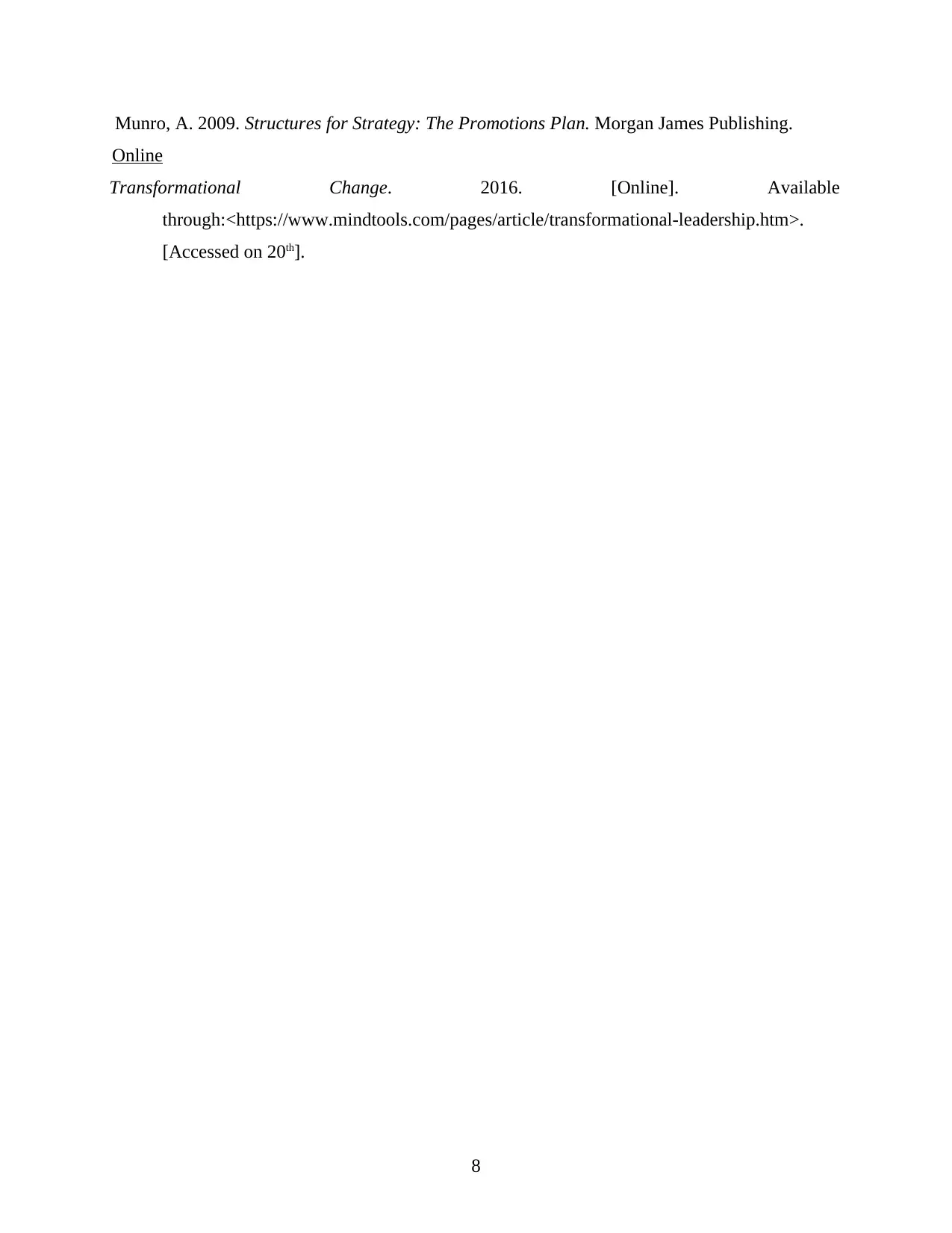
Munro, A. 2009. Structures for Strategy: The Promotions Plan. Morgan James Publishing.
Online
Transformational Change. 2016. [Online]. Available
through:<https://www.mindtools.com/pages/article/transformational-leadership.htm>.
[Accessed on 20th].
8
Online
Transformational Change. 2016. [Online]. Available
through:<https://www.mindtools.com/pages/article/transformational-leadership.htm>.
[Accessed on 20th].
8
1 out of 10
Related Documents
Your All-in-One AI-Powered Toolkit for Academic Success.
+13062052269
info@desklib.com
Available 24*7 on WhatsApp / Email
![[object Object]](/_next/static/media/star-bottom.7253800d.svg)
Unlock your academic potential
Copyright © 2020–2025 A2Z Services. All Rights Reserved. Developed and managed by ZUCOL.





